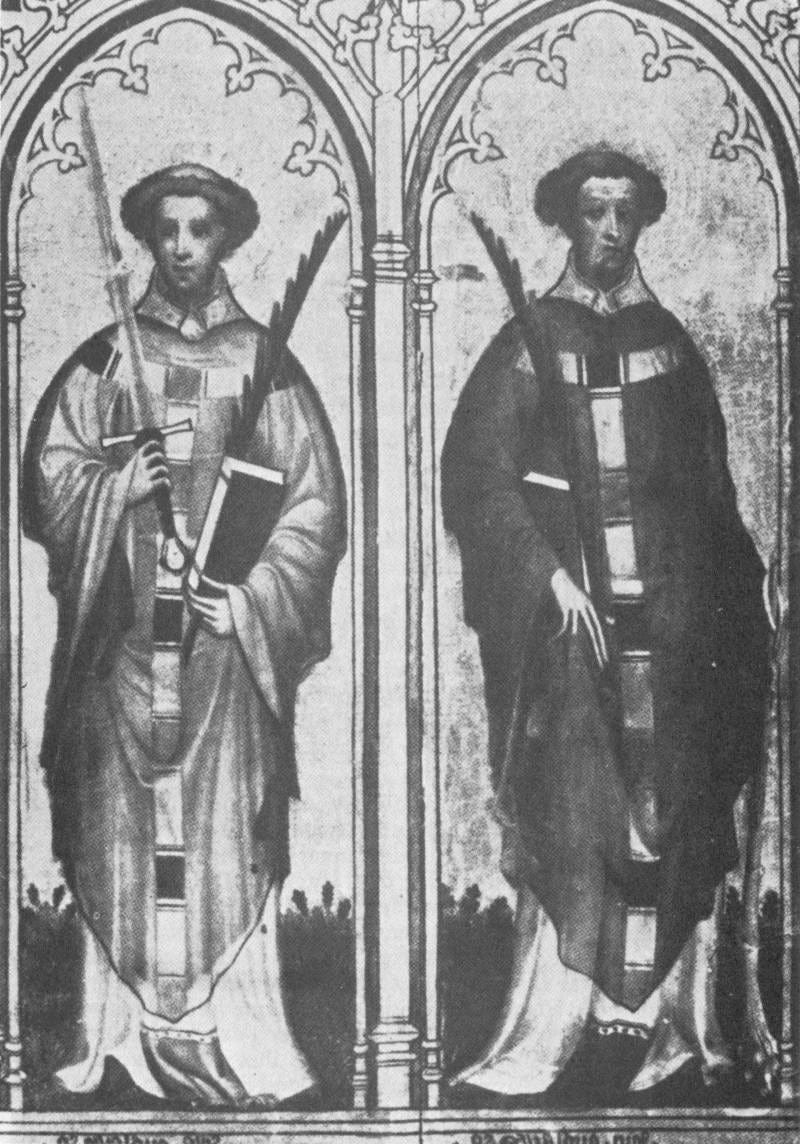Hewald 'the White' and Hewald 'the Black': seventh century missionaries and martyrs
In the hunt for pre-Conquest nicknames, it’s easy to be drawn in by the amusing and extreme examples: the Alfred ‘Toad Testicles’ of the world. But if we’re interested in how these nicknames work, how they are created and circulated and what they might ‘mean’, we need to pay as much attention to the more ‘mundane’ examples.
To that end, we find a fascinating example of nickname use in the case of the two seventh-century martyrs both named Hewald, distinguished from each other by the nicknames ‘the White ‘ and ‘the Black’.
15thC painting of the two Hewalds at the Church of Saint Kunibert (Cologne)1
Our most extensive account of the two Hewalds, found in Bede’s Ecclesiastical History, suggests:
Two English priests who had long lived in exile in Ireland for the sake of their eternal fatherland, came to the kingdom of the Old Saxons in the hope of winning some in that land to Christ by their preaching. They both shared the same devotion and also the same name, for they were both named Hewald, but with this distinction that because of the different colour of their hair one was called Black Hewald and the other White Hewald; both were full of religious devotion, but Black Hewald was more learned in the holy scriptures.2
Despite their desire to talk to the local viceroy, to encourage him to convert to Christianity, the two Hewalds are stalled by their host. While waiting, their alien activities attracts attention:
When the barbarians saw them continually engaged in psalms and prayers and daily offering up the sacrifice of the saving Victim to God - for they had sacred vessels with them and a consecrated board instead of an altar - they realized that these men were of a different religion. […] So they seized them suddenly and put them to death. They slew White Hewald quickly with a sword but Black Hewald was put to lingering torture and was torn limb from limb in a horrible fashion; their bodies were thrown into the Rhine.3
Grim stuff.
This account is accompanied by a number of miraculous occurrences; we are told that the bodies flowed upstream along the Rhine towards their companions, and that they were illuminated by a heavenly ray of light before being brought to Cologne by Pippin to be buried. Their point of martyrdom is supposed to bring forth a bubbling spring.
This is not the only time that these two individuals appear within our surviving written texts; Henry of Huntingdon’s Historia Anglorum, a history compiled in 1135 at the bequest of the bishop of Lincoln, repeats the story in similar fashion. The Old English Martyrology references the 3rd October, their date of martyrdom, as their passion.
But beyond this, we’re in the dark.
The two Hewalds are a useful example to the historian of a number of topics: (self-imposed) exile, the processes of preaching and attempted conversion, contemporary understandings of martyrdom. But, viewed by the onomast (that is, those of us interested in names and naming), their significance is really two-fold.
First, Bede’s account provides an explicit origin for their nickname. This is an incredibly rare occurrence in early medieval texts; from my data collection so far, it occurs in about 1% of cases. Now, we have no evidence that the explanation that Bede provides, of hair colour, is an accurate representation of a genuine origin; we have ample evidence for later authors creating explanations for earlier nicknames and perhaps Bede wanted to explain the origins of a nickname he had heard. Certainly, contemporary sources point towards a number of other possible explanations for nicknames that references black and white: skin tone, morality/spirituality, anecdotal references to past activities. But references to hair certainly appear to be frequently referenced in contemporary nicknames, both as colours [eg. perhaps William Rufus, the second Norman king of England, †1100] and references to hair styles [eg. Eadric the Bald in Domesday Book];4 Bede’s suggestion is therefore perfectly viable.
How many explanations were passed between contemporary individuals that are now lost to the modern historian? How many convoluted explanations of nickname ‘meanings’ can now never be known?
Also interesting is the fact that the nicknames of the two Hewalds appear in direct relationship with each other; they are given their nicknames to distinguish between each other. It frames nicknames as a functional tool of differentiation; had one Hewald set out on his mission alone, would he have had a nickname? Now, we know that this functionality is not always the case, and that nickname-giving is also creative rather than simply brutally functional. But how many of the examples that we find in isolation were originally created to stand in opposition to another (unrecorded) individuals, sharing a first name but differentiated by a different nickname?
These are largely, sadly, unanswerable questions. But the example of the two Hewalds, the White and the Black, provides us with a wonderful example of the mundane and necessary process of nickname giving and use in early medieval Europe; a need to distinguish between two people sharing a name leads to the creation of two nicknames, drawn from their appearance.
If you’d like to know more about early medieval nicknames, please sign up to the newsletter (for free) using the box below.
https://en.wikipedia.org/wiki/Two_Ewalds#/media/File:Ewalde_scan.jpg It’s incredibly hard to find pictures of these obscure individuals, so please forgive the Wikipedia source here…
Bede, Historia Ecclesiastica, eds. and trans. B. Colgrave and R. A. B. Mynors (2 vols., Oxford, 1991), i.481.
Bede, Historia Ecclesiastica, eds. and trans. B. Colgrave and R. A. B. Mynors (2 vols., Oxford, 1991), i.483.
https://domesday.pase.ac.uk/Domesday?op=5&personkey=53982





Great stuff yet again!